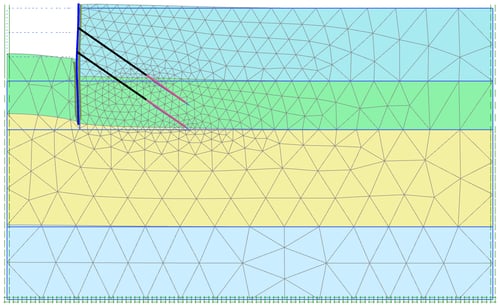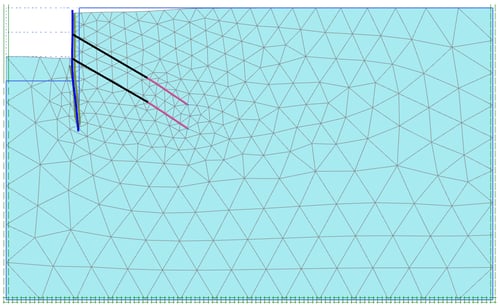Virtuosity Blog
On the Importance of an Appropriate Soil Model
Numerical modelling of geotechnical applications requires appropriate soil models to obtain realistic and accurate results. In this respect, a simplified model like the linear elastic perfectly plastic Mohr-Coulomb model can be regarded as inappropriate, since it lacks important features of real soil behaviour. If you are still addicted to Mohr-Coulomb, it’s time to move on. In this blog I will explain why, and what are the better alternatives.
Features of soil behaviour
Compared to other ‘engineering materials’ like steel and concrete, soil is a much more complex material. Typical ‘engineering properties’ of soil, such as ‘strength’ and ‘stiffness’ depend on many other properties and on the particular conditions that apply in the situation at hand. For example, soil strength and stiffness depend on the stress level, the loading direction, the strain level, short or long term, density, over-consolidation, and several more. Stress-dependency and strain-dependency of stiffness and strength are some of the ‘features of soil behaviour’. Other features are compaction and dilatancy, drained or undrained behaviour (the latter involves a simultaneous change of pore water pressure), creep, anisotropy, structure, and several more.
Constitutive models
Geotechnical Finite Element programs, like PLAXIS, use constitutive models to model the mechanical behaviour of soil and rock layers. Constitutive models, or in short, soil models or rock models, are a theoretical framework for the relationship between stress and strain (and time); it is the qualitative description of the soil or rock behaviour in the computer program. The linear elastic perfectly plastic Mohr-Coulomb model is a simple combination of Hooke’s law of isotropic elasticity and the generalised Mohr-Coulomb failure criterion formulated in a non-associated plasticity framework. This sounds complicated, but, in fact, it isn’t; it provides only a bi-linear stress-strain relationship, which is far from realistic, because it lacks many features of real soil behaviour.
More advanced soil models, such as the Soft Soil model and the Hardening Soil model with small-strain stiffness (HSsmall), are based upon more complicated theories. They have been validated based on many test results and several real-life applications. As a user, you do not need to fully understand the theories behind, as long as you are aware of the capabilities and limitations of the models and how to determine the corresponding parameters. Some constitutive models are more appropriate for soft soils; others are more appropriate for harder types of soils and some models are applicable for rocks or other engineering materials; and there are also special models for dynamic applications (earthquake simulations) or for temperature-dependent applications. It is important to choose the right model in accordance with the type of soil and the features of soil behaviour that are considered relevant for the application at hand.
Images shown below: Staged undrained construction of an embankment on soft soil

Image: Using Mohr-Coulomb model with effective strength parameters: No failure (stable)

Image: Using Soft Soil model with effective strength properties: Failure (instable)
Model parameters
Besides the model itself (theoretical framework; qualitative description of soil behaviour), the model parameters are there to quantify the soil properties (stiffness, strength, etc.) in the constitutive model. Admitted, more advanced soil models generally have more parameters that need to be determined based on site investigation data, which is usually scarce. This is a reason why some engineers stick to simple models, because they think it will cost them less time and effort to determine the parameters. However, appearances are deceptive, since parameters in a simple model cannot be determined unambiguously for most practical applications. On the other hand, parameters in advanced soil models have a much more precise meaning and can mostly be determined unambiguously for each soil layer.
Simple models can be dangerous
Simple models lack important features of soil behaviour. In some cases, this may lead to dangerous situations. Some examples:
- Soft soils show a reduction of effective mean stress under undrained loading conditions, which results in undrained shear strength (su) that is less than what would result from the initial effective mean stress. Linear elastic perfectly plastic models do not capture this reduction of effective mean stress. Hence, they overpredict the soil’s undrained shear strength when modelled by even the correct effective strength properties (φ’, c’), which can be dangerous. See first example below.
- Simple models do not distinguish between primary loading and unloading or reloading. When using such models in excavation projects to predict deformations around the retaining wall, unrealistic heave of the wall and heave of the soil behind is often found. Practitioners know that excavations always cause settlement instead of heave. Simple models predict the opposite, which can be dangerous. See second example below.
There may be ways to avoid this dangerous behaviour of simple models by means of ‘engineering fudgement’. However, my advice would be to use more advanced soil models and rather spend your time on a proper determination of the model parameters. The model does then most of the job for you.
Image shown below: Staged excavation, supported by an anchored retaining wall

Image: Using Mohr-Coulomb model, showing unrealistic heave of the soil behind the retaining wall

Image: Using the Hardening Soil model with small-strain stiffness showing realistic settlement behind the wall
Note:
1. Instead of sub-dividing the homogeneous soil into multiple sub-layers, as necessary for the MC model, the soil can simply be modelled with a single layer using the HSsmall model.
2. Deformations are plotted on an exaggerated scale.
3. The heave of the excavation bottom (swelling) is a result of unloading, but is generally not noticed in practice, since it is simply excavated.
More to come
After reading this contribution, I hope to have challenged you to consider the use of advanced constitutive models in your next geotechnical finite element application. In the next series of blogs I will focus on some such models with the purpose to take away the fear and make you more confident of using them.
An important hurdle is the determination of model parameters, especially since good site investigation is often lacking in an early stage of a project. I would like to mention our preliminary work on a tool to help you with parameter determination of advanced soil models, as announced in my Geostrata article two years ago (Brinkgreve, 2019). Starting from basic field test data (CPT, SPT), the tool uses chains of correlations to propose parameter values, and it transparently shows how they are calculated. This shall stimulate the use of advanced constitutive models and it shall lead to more consistent results from geotechnical finite element calculations.
LinkedIn Live: PLAXIS Soil Model Talk with Dr. Ronald Brinkgreve
Reference
Brinkgreve RBJ (2019). “Automated Model and Parameter Selection”. Geostrata Jan/Feb. 2019. ASCE Geo-Institute. 38-43.
Learn more about PLAXIS with Virtuosity:
Interested in PLAXIS soil models? Find more resources here.
Want to learn the specialized material models in PLAXIS 2D and 3D? Read here.
Get access to new educational PLAXIS videos to explore the benefits and value of using PLAXIS.
For the price and the amount of Keys included in PLAXIS Virtuoso Subscription, please visit this page.
Want to learn more about what PLAXIS can do for you? Don't hesitate to contact our geotechnical experts. We are happy to help.

